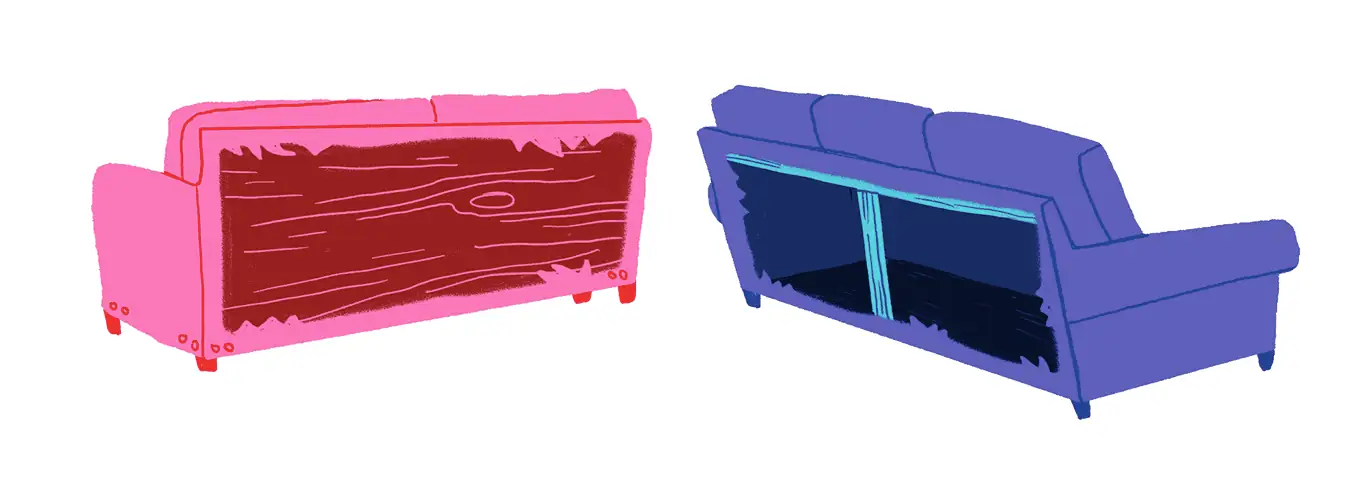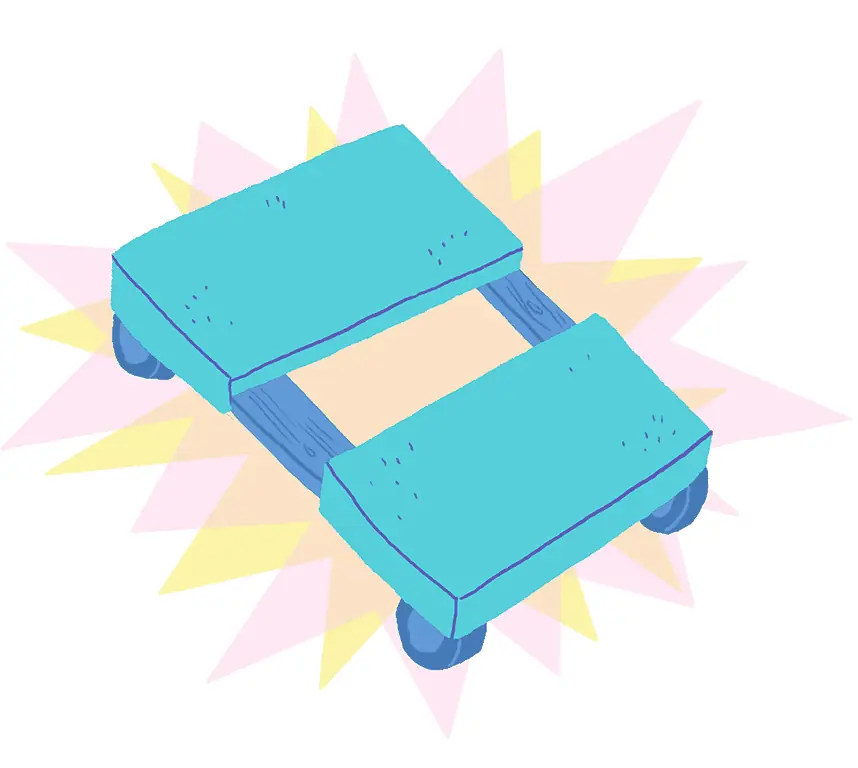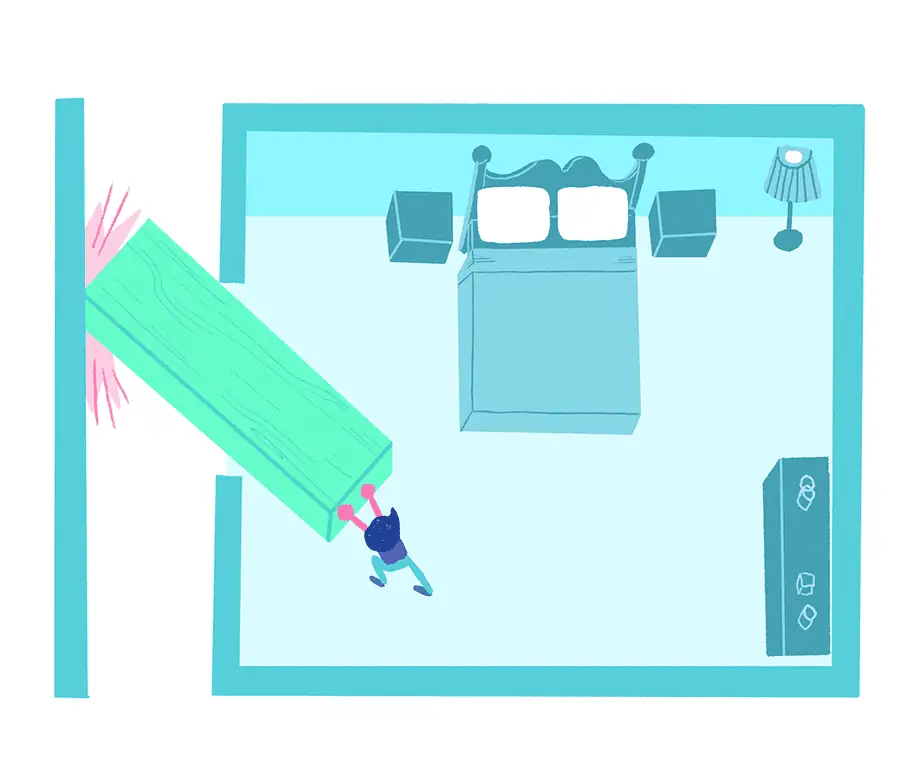The Furniture Dolly: How To Move Heavy Furniture
Posted in: Loading & Unloading GuidesHow do you move large pieces of furniture? It’s a question we hear all the time. It’s a daunting prospect, having to haul heavy, bulky items like dressers, bookcases and entertainment units from your house to your moving vehicle.
Fortunately, there are several ways to do it safely.
The Furniture Dolly
At first glance, a furniture dolly is not very impressive. It’s just a rectangle on wheels. Barely six inches tall. No handles. No straps. Most likely made of wood and sporting a curious inability to roll straight when given a push.
But don’t let its modest appearance fool you. A furniture dolly can help you move just about anything you can put on it, making it your best back-saving friend when it comes time to move.
Is It Safe to Put Furniture on a Furniture Dolly?
You bet! A good quality furniture dolly can handle upwards of a thousand pounds – more than most people need, and certainly, more than most people can lift. (No matter how many friends they’ve gotten to come help.) Even a less-expensive dolly can handle a few hundred pounds. Just be sure to check the specs before you bring it home and put it to work.
Can a Furniture Dolly Move Tall Things Like Bookcases or Long Sofas?
The simplicity of a furniture dolly makes it versatile enough for items of just about every shape and size, and is great for hauling stacks of boxes too! Long chest of drawers? Tall china hutch? Bulky, heavy armoire? That little 4-wheeler (as many movers call it) can handle it all and then some, allowing you to move your stuff over long distances with minimal effort and strain.
How Much Is a Furniture Dolly?
Want one to own? A furniture dolly usually costs somewhere between $20-40, varying slightly depending on how many hundreds of pounds they can hold. (Usually starting around 800 pounds.)
Just need to rent one? If you’re renting a moving truck, often times rental truck companies offer furniture dollies for about $7.
Department stores like Home Depot tend to have them for around the same $7-10 mark. Or if you’re hiring movers, they usually provide tools such as furniture dollies free of charge that they themselves use to move your stuff.
Is a Furniture Dolly Easy to Use?
It’s totally safe and simple to utilize … but only if you know how to use it. Make sense? Cool! Here’s how to use a furniture dolly.
The Basics of How to Load
Putting a piece of furniture on a furniture dolly is just that: putting it on. Carefully lift a piece of furniture up and place it to where the furniture dolly is located on the center-most flat surface of the furniture.
But it’s more complicated than just that.
Sure, some items can sit on a dolly the same way they sit on the floor. As long as there’s a flat bottom surface that can support the weight of the item there’s no need to lower it onto its side or tip it onto its back or turn it completely on its head.
But other times, you’ll need to load the furniture a different way. Here are the most important things to know.
- Map out your exit route to where you are loading it. This is a major mistake waiting to happen. If you aren’t going to be able to angle that long dresser into a hallway, there’s no sense in sitting it horizontally. Likewise, if your armoire just barely clears the top of the doorway, you probably won’t get it through on a dolly.
- Safely figure out which side of that piece of furniture you’ll put downside. This is what the pros follow: sit tall items like bookcases and armoires on their sides, and long items like dressers upside down. If it has legs or a hollow underside, it won’t rest properly sitting upright. Yes, you’ll have to turn it sideways or even upside down. And before you lay it on its back, understand that the back sides of many pieces of furniture are not fashioned to support a tremendous amount of weight, so use your best judgment.
- Empty out armoires and bookcases before attempting to load them. A chest of drawers can be moved without being emptied, assuming there’s nothing inside except clothing. Emptying and taking out drawers will make it noticeably lighter and more manageable, so always weigh your options. (Ha.)
- Secure any doors and drawers that might fall or slide open. This can easily be done with large mover’s rubber bands or lengths of string that tied tightly. Some people choose to wrap their furniture with pads before moving them and this will absolutely keep those doors and drawers closed, but keep in mind that while essential, furniture pads can make it more difficult to maintain a firm hold if you have to carry it up or down a flight of stairs!
How To Load Your Long Piece On End
This is probably the most precarious way to both load and transport a piece of furniture on a dolly because, well, physics.
But like I said, in narrow spaces and tight corners it sometimes is the only way. Here we’ll go through it in a two-person scenario because we don’t encourage loading a piece like this on your own.
- Position your dolly on the floor close to (but not up against) the side of your dresser (or long piece). Tell your friend to attentively stand by.
- Lift the side of your dresser opposite your furniture dolly until the side of your furniture facing down touches the dolly. (Make sure you clear the item from the wall and any other potential obstruction!)
- Raise your dresser onto the dolly while your friend holds the dolly in place until it’s in a vertical position, keeping a firm hold to prevent tipping or rolling awry. Don’t be afraid to lower the dresser back down, taking its weight off the dolly to let your friend adjust the dolly’s position. You absolutely want to ensure the dresser ends up sitting balanced and square on the dolly. (You may have to try a few times.)
- We recommend two sets of hands for rolling it across the floor and down the hall. The person in front steers and watches for obstacles while the person in the back pushes (gently). Both of you need to constantly be on guard to make sure the item doesn’t begin to tip ever so slightly.
Protip: If the top of your dresser has a lip or overhang that extends beyond the surface of the side resting on your dolly, allow that lip to hang over the edge of the dolly so that dresser sits flat and vertical.
Loading Your Tall Piece on Its Side
The basics here are the same as in loading it on end, although the geometry and the dynamics make it possible to handle this type of situation on your own. (Still, we believe four hands are always better than two.)
- Position your dolly on the floor near the face-down side of the piece.
- Working from the same side of the piece as your dolly, pull the top of the piece toward you. Lower it slowly, eyeing your dolly and nudging it into a place where your piece will be balanced once it is resting fully on the dolly.
- Maintain control by keeping that dolly in place with your foot. This part gets trickier the taller your piece is, so take care to keep both your piece and yourself steady. As in the previous example, your dolly may begin to kick out as the weight of your piece comes down on it, so if at all possible, have someone lend you their hands.
- Lay flat and push! Assuming your piece is sitting square and balanced on the dolly, pushing it across the floor should be a relative piece of cake. Just take care taking those corners since those top and bottom ends are now sticking way out in front and back of the dolly.
Protip: Your furniture has legs? When tipping heavy pieces of furniture with legs, be very aware of the weight of your object. The longer and slimmer the legs, the better chance they will snap under the weight. Whenever possible, grab a friend or two to help keep the weight off those legs as you lower the piece down onto your dolly.
Loading Your Sofa

- If the backside of your couch has a solid surface beneath the upholstery, all you need to do is center your dolly behind your couch and tip your couch on its back and you are rolling!
- If your sofa has a frame that leaves a lot of hollow area under the upholstery, you may have to work quite a bit harder to get your dolly in a place where it will support that sofa without tearing through anything.
- Hollow? A piece of plywood or another flat source of support placed on top of your dolly can compensate for what your sofa lacks. A few flattened moving boxes may lend enough support for the job, as will a couple of two-by-fours that, when laid crossways on your dolly, will support your sofa from the top edge to the bottom.
Protip: This same strategy of using plywood, cardboard or a couple of pieces of scrap lumber to create a wide, flat surface is also useful when stacking boxes on your dolly! Or when moving odd-shaped items like exercise machines and pieces of art.
Things to Watch Out For
Once you’ve rolled that dresser or sofa safely out the door, down the driveway and up to the truck, you may think that all is well. But pushing that piece of furniture up the ramp and onto the back of the truck comes with its own hazards.
- Keep one eye on the ceiling so you don’t destroy any overhead light fixtures or smoke alarms. Also be on the lookout for anything potentially high up on the walls, like smoke alarms or fuse boxes.
- Unless your front door (or any door) swings 180 degrees, the edge is going to be sticking out, leaving a clearance of however wide your furniture is minus one-half inch.
- Take care not to crush your knuckles against those door jambs! (It hurts, trust me.)
You also need to keep an eye on the floor. A throw rug, the uneven spaces between floor tiles, even something as small and unassuming as a Lego can stop your dolly … while whatever is sitting on top of it keeps moving forward.
- Coaxing your furniture up a ramp is not wise or easy. Any item sitting low and long can stretch beyond what the angle between the driveway and the ramp will allow, scraping up the ramp while the wheels of the dolly are still on the ground. You might do well to turn your dolly ninety degrees so you can push that piece of furniture (carefully!) sideways up the ramp. (Make sure the side with the drawers and doors is facing upward!)
Protip: It should be obvious that furniture dollies are not at all useful anywhere there are stairs involved. It may be tempting to be creative, but believe me, 4-wheelers and staircases do not mix. Grab a friend, or a few, and carry that piece of furniture slowly and carefully.
Does This All Seem Like a Lot of Work?
I’ve been moving furniture for decades, and trust me, some people just shouldn’t be moving their own furniture. At the end of the day, it’s hard work, and professionals are professional for a reason. With that said, if you’re going to do it yourself, you need to make sure you do all the stuff above so you don’t hurt yourself (not to mention your valuables).
See prices for movers by the hour – instantly.
Read real customer reviews.
Easily book your help online.
Even if you only need to get movers to move your heaviest stuff, it may be totally worth it to just check to see who is around you and what they charge to help. It may be a lot more affordable than you think.
And don’t worry, they’ll bring the furniture dolly.








 You also need to keep an eye on the floor. A throw rug, the uneven spaces between floor tiles, even something as small and unassuming as a Lego can stop your dolly … while whatever is sitting on top of it keeps moving forward.
You also need to keep an eye on the floor. A throw rug, the uneven spaces between floor tiles, even something as small and unassuming as a Lego can stop your dolly … while whatever is sitting on top of it keeps moving forward.



